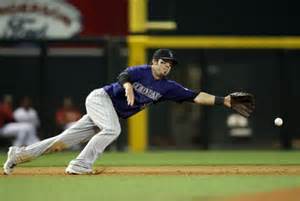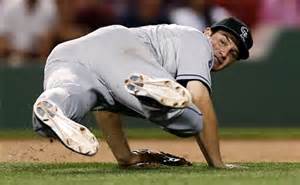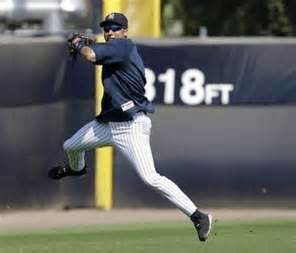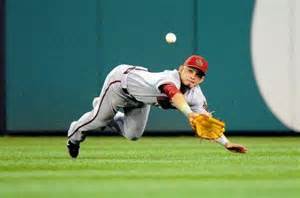Drills Baseball - How To Control Forward Momentum
Drills Baseball and Hard Work are the only sure fire methods for improving your skills, and some of these skills have not really changed since the inception of baseball, with the exception of equipment advances.
I always taught, what some people may perceive as an Aggressive style of fielding, because it brought out the best in the players as they strove to increase their skill level.
From Tee-Ball to the Minor leagues, an infielder is taught to go after and catch any ball you can get to, which is why you’ll see the third baseman cutting in front of the shortstop, the shortstop going deep behind second base fielding the ball before it gets to the outfield, and the second baseman running far to his left, giving chase to fly balls in foul territory far behind first base.

Drills Baseball - Giving 100%
Strategy and Drills Baseball
This type of aggressive defense was not my creation, but rather an age old strategy which is proven through logic and a little sprinkling of common sense.
One instance is, if the third baseman quickly reacts to a ground ball hit to his far left and fields the ball by cutting in front of the shortstop, who is in fielding position to catch the ball, but 5 to 10 feet farther away from home plate than the third baseman, the third baseman will:
(1.) Be moving towards first base which establishes his forward momentum, thus eliminating the need for a crow hop….
(2.) Will field the ball sooner resulting in less time lapsed between catch and the first baseman receiving the throw ….
(3.) Will have a shorter throw to first base, making the play happen quicker, resulting in getting even the speediest runner out.
Any ball hit to the 3rd baseman’s extreme left and fielded by the shortstop, who will have been forced to move deep into the hole, will require a strong, accurate throw from a great distance, in order to get the runner out.
Field any ball you possibly can and if you can’t reach the ball, the shortstop is there to back you up and make the play. No rocket science here.

Drills Baseball - Try For Every Ball
There’s an old saying “Better Lucky than Good” and even at the big league level there’s a certain amount of luck involved in every aspect of the game, but for the most part the ability to make these types of plays are the result of fielding countless numbers of ground balls, hit in all speeds and angles, which sharpen the player’s ability for correct anticipation, lighting quick reflexes and a “never say quit” attitude, which the first two can be enhanced by good coaching, but the last is born of an individual player’s intestinal fortitude.
After the Catch and Drills Baseball
Skill building requires stages and of course getting to the ball is the first step, but we must be careful to not linger on one step too long before advancing, because sometimes reaching the ball is not the most difficult part of the play, but rather being able to bring your body under control in order to complete the play, can become the main issue.
Staying with the example of the third baseman cutting in front of the shortstop to field a ground ball, consider what your physical positioning on this play is most likely to be. It’ll be bent over at the waist, low to the ground, arm fully extended, moving sideways quickly with your head leading the way, which creates a severe Off Balance problem for the body.

Drills Baseball - Falling Forward
There is an old and truthful adage in boxing, which simply states “As the head goes … the body will follow.” In our particular scenario our head is creating a natural balance problem, which along with our extreme forward momentum, prevents us from being able to throw the ball period, much alone with any authority, which keeps us from being able to complete the play by getting the put out.
Our upper body is too far ahead of our hips and legs, it is not possible to suddenly stop and become set in order to make a throw, as the sudden stop will result in you falling forward to the ground, and throwing from the belly is quite difficult.
Unable to stop, due to our speed, the only option we have is to attempt to twist the upper half of the body to face the target, and throw off balance and/or across our body, a very poor method for getting any velocity on the ball.
This may work in certain situations, such as a shortstop being within a few feet of second base and more or less flipping the ball to the second baseman for a force out, but that is just about the only time it will work as throwing for distance from this contorted position is impossible.
So how do we regain command of our body and stop our forward momentum? Simply speaking, we don’t stop it … but rather we redirect it.
Remember your basics …
1. See the ball …
2. Catch the ball …
3. Throw the ball…
We have fielded the ball, now we must first regain control of our body in order to make a throw. In order to do that, we redirect our forward momentum by spinning or turning all the way around in a circle, which naturally channels our forward momentum towards our target and allows us to make a strong throw.

Drills Baseball - Leaping To Control Momentum
Always attempt to spin to your left, which will allow the body to follow the natural flow of your momentum while changing directions. An important thing to remember as you are spinning, is to keep your eyes open and focused, which keeps you from becoming disoriented and throwing the ball too soon or too late to the target.
In theory, if the maneuver is performed correctly, as you come out of your turn, you are not only facing your target, but are also moving towards it as if making a crow hop, which allows you greater accuracy and velocity on your throw.
Practicing the Spin: and Drills Baseball
No doubt the physical skills required to properly perform the redirection of your momentum play are great, but not extraordinary and can be learned by most any player.
No different than any other skill drill, Repetition is the key to success, and for this drill the number of times you practice the play is only limited by your desire, as you can easily perform this drill by yourself.

Drills Baseball - Spin Sequence
You’ll be using a tennis or rubber ball, I recommend a hard rubber ball, which will bounce and doesn’t damage the wall no matter how hard or often it hits it.
(1.) Using a flat surface, the back of a garage, handball court, brick wall or something similar, use duct tape and make a large box on the wall representing the first baseman.
(2.) Throwing the ball at an angle to the wall will result in the ball coming off the wall at an angle. Using this throwing technique, mimic the movements you’d use to field a ball to your left, spin around as if redirecting your momentum and throw the ball at the target.
(3.) Remember, the intent of this drill is to accustom the body to the feeling and duration of the spin, while learning to focus the eyes to know exactly where you are in relation to the target as you come out of the spin and gaining accuracy of hitting the target.
(A.) Begin this drill slowly, as you don’t want to develop any bad habits and they usually begin at the start of learning a new skill. (Muscle Memory)
As you gain experience and confidence, increase the speed in which you perform the drill, varying speed of the ball and where it hits on the wall. The lower the throw … the lower the ball comes off the wall.
I have found drills which mimic reality are the best teaching tools, because in a game situation you will simply react and execute the play as you have practiced a thousand times.
Diving Catch Drill: and Drills Baseball
Seems as though a week doesn’t go by during the season where a terrific diving catch by an outfielder doesn’t make the sports highlights, and rightfully so as these are great physical feats, but do you realize there’s a drill they perform to prepare for those situations?
The diving catch drill can be performed inside or out, inside requires a padded mat, but preferably outside in the grass for actual game conditions.
The Outfielder begins by kneeling on both knees and won’t stand back up until the drills are complete. The coach stands 7’ to 10’ away in front of the outfielder and throws, underhanded, simulated line drives or sinking drives, to the outfielder’s left and right side 3’ to 5’ away from him.
The outfielder must lunge forward from his knees and catch the ball, which assimilates the player being laid out as he would be leaving his feet as he dove, and hitting the ground with your body.

Drills Baseball - Dive Drill
The speed and impact of the knee drill doesn’t match live play, but the player learns to follow the ball into the glove from an entirely different perspective, times the ball to the glove and we’ve already proven the value of pre-programming mentally and muscle memory, which makes the drill very effective.
Cone Drill:
An outfielder is taught to circle a ground or bouncing ball and to Run Through It in order to get a running start towards his target.
This circling of the ball is easier said than done because of the instinctive desire to run a straight line in order to reach the ball as quickly as possible. This is where the Cone Drill can actually facilitate the circling of the ball.
Take 5 to 6 orange cones and place them about 5’ apart forming a large C configuration. The outfielder will begin at the first cone, and the coach will throw ground balls to the left of the C formation. The outfielder will be forced to run around the cones, which have been carefully set up to simulate the proper circling method, which teaches him the actually feel of circling the ball and running through it.
Once again, muscle memory and mental adaptation, to feel the movements and void the tendency to take a straight line approach to the ball.
Drills Baseball To How to Play Infield

New! Comments
Have your say about what you just read! Leave me a comment in the box below.